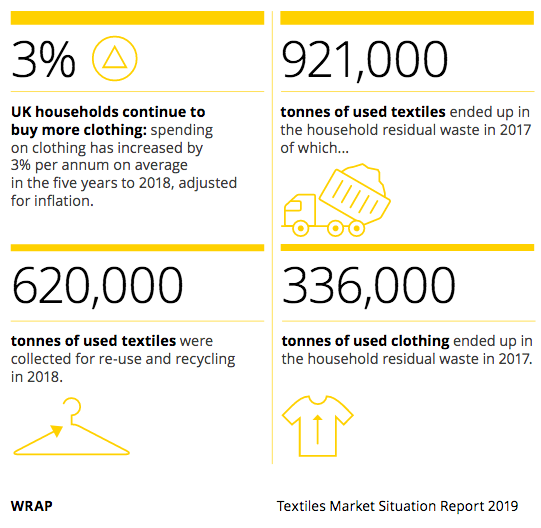
A few quick thoughts on this, in part to try to organise things in my head. Clothing is one area we're focusing on in our work, to make stronger links between waste reduction and action on climate. But as this blog outlines, it's complicated. 1/
https://twitter.com/TheSocBiz/status/1452596276713988107
The fashion industry is estimated to account for 4% of global carbon emissions, so it matters. 2/
Clothing is a complex system, so understanding where there the environmental impacts are, and subsequently where action is best taken to have most impact, is challenging. Growing/manufacturing materials, dyeing, making the garments, transport, retail, wear, care, disposal.... 3/ 

As highlighted here, 38% of the clothing industry's greenhouse gas emissions are related to the production of the materials used (production of cotton, wool etc; pesticides & fertilizers; production of oil-based synthetic fibres etc). medium.com/policy-leeds/r… 4/
And then 33% of the industry's emissions come from processing of materials into garments - spinning, weaving, knitting dyeing, making the garments. In reality only 4% of total emissions come from making the actual items of clothing. Dyeing etc more significant. 5/
Then you've got transport, and that accounts for around 4% of the greenhouse gas emissions of the clothing industry. medium.com/policy-leeds/r… 6/
I can't see a figure for emissions from retail (I'll ask) but next bit is obviously where we all come in. “Third largest contributor to industry’s emissions come from consumer phase of the garment lifecycle. Washing, drying and ironing contributing 20% of total emissions..." 7/
And we do love buying clothes in this country. On average, we buy 26kg (that's not a very relateable stat is it?) of clothing each year. More than most other countries. And we're wearing each item less often. More here - policyconnect.org.uk/research/net-z… 8/
And this all results in many of us having wardrobes full to bursting with clothes. There are various estimates out there of how much clothing that adds up to. And how rarely some of those things have been worn, if at all. 9/ uk.fashionnetwork.com/news/Britons-h…
And then what do we do when we no longer want those clothes? There's some detail in this Wrap report (detail in the thread). Lots reused or recycled, but plenty ends up in the bin (and then incinerated/in landfill) too. 10/ 
https://twitter.com/TheSocBiz/status/1214936771219329024

We did some analysis of what this means at a local level - it's estimated that 4000 tonnes of clothing & textiles are thrown away by Leeds householders each year - equivalent to 12kg per household. This will be incinerated at the RERF in Cross Green. 11/
The next bit in the blog is interesting - & something that's often missing in these discussions - an understanding of psychology behind choices we make.
"...We need to understand consumer psychology and the role of fashion in culture and society.” link.medium.com/A0MKy43NDkb 12/
"...We need to understand consumer psychology and the role of fashion in culture and society.” link.medium.com/A0MKy43NDkb 12/
“Fashion is the most powerful nonverbal status device humans use, which conveys the groups we associate with, our position in those groups & at a very basic level, how we attract a mate." < What are the implications of that for carbon-reduction plans? 13/ link.medium.com/A0MKy43NDkb
Which brings me back to the start. It's complex. But it's also important we find a way through the complexity & act where we can. Understand what we can do as individuals, together, & how we can influence businesses & governments. Understanding how the system works helps. 14/14
@threadreaderapp unroll please
• • •
Missing some Tweet in this thread? You can try to
force a refresh







